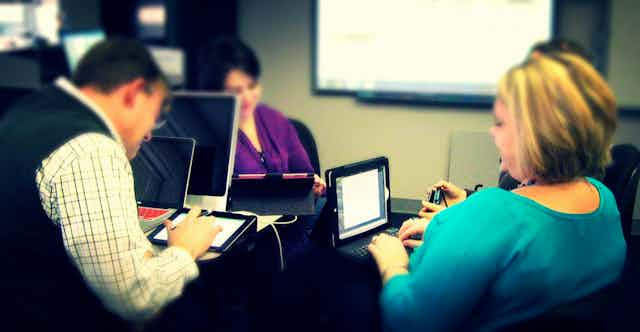We assume that digital technology can improve education and that the challenge is how to bring innovative technology and educational professionals together. But the evidence shows that despite massive investment, digital technology has not resulted in significant improvements in learning experiences or attainment in education.
Many of the barriers to the effective implementation of digital technology to enhance education are well understood, and relate to human factors rather than technological ones. It has been argued that no amount of technology will transform education because it is people who bring about change.
That is why I argue for the importance of continuous professional development (CPD) for teachers.
We know a great deal about what effective CPD looks like, both in general and specifically in relation to using digital technology to enhance learning. Implicit within the term CPD is the notion that teaching is a profession.
Bob Burstow recently questioned whether this was the case, and I have to admit that I no longer think that teaching, at least in England, is a profession. Let me explain.
What makes a professional
We would all recognise the following traits as being key features of a profession. Knowledge of the underpinning principles and theories in your field. A requirement for regular updating and/or re-accreditation. Being the creators and curators of knowledge within your field. Not working a fixed number of hours. Having a degree of autonomy, within the constraints of appropriate professional standards, to decide what you do and how you do it. Having an independent professional body that sets and maintains those standards.
But since the late 1980s all of these things have been eroded or totally missing for teaching in England.
In 1987, teachers’ terms and conditions were changed to specify the number of hours a year that they should work (1,265 hours over 195 days per year). This was a shift away from an expectation that they should work the hours that were necessary.
In 1988, the national curriculum was introduced. This took away teachers’ autonomy to decide what to teach. Then in the late 1990s the National Strategies on learning were introduced after New Labour came to power. These undermined teachers’ autonomy for deciding how to teach. While the National Strategies were discontinued in 2011 they impacted on the culture of teaching – undermining teachers’ perceptions of their autonomy and authority.
Alongside these developments were changes to the curriculum for initial teacher education, which are reflected in this now being referred to as initial teacher training. These involved reducing time spent on understanding how children learn (learning theory) and thinking about what school is for (educational philosophy). This was done in order to make room for training on how to structure teaching – such as the three part lesson – and how to deliver specific approaches such as synthetic phonics. However, it undermined teachers’ understanding of education’s underpinning principles and theories.
There is no requirement for teachers in England to undergo professional updating or re-accreditation. They are not expected to engage with, let alone carry out, educational research. And up until now they have not had an independent professional body.
Of course there are many individual teachers who are professionals and who recognise the need for teaching to be a profession. That is why there is such strong support for the formation of the College of Teaching. This is a critical step towards re-professionalising teaching.
However, it would be foolish to think that it will be able to redress the problems inherent in the revised national curriculum, or even help teachers prepare to deliver the new computing curriculum from September this year.

